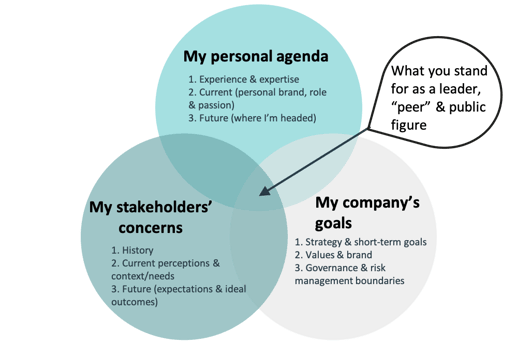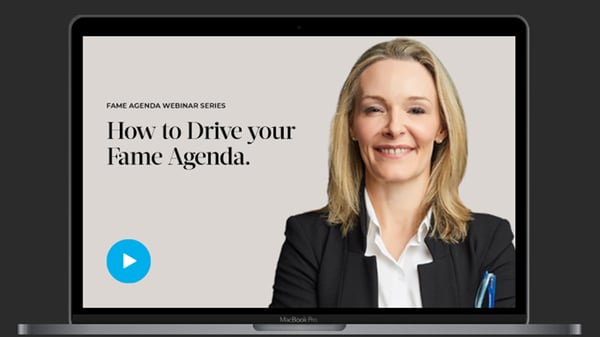Brands in 2020 are about people. Stakeholders no longer trust a corporate entity in the same way they once did, but they do buy in to a human face. In these particular times, you might have a renewed focus on your individual profile – to leverage it in your current role, to build your long-term career prospects, to use your expertise to inform and educate, or to use your influence for change that matters to you.
If you are not a marketer, you might not think much about your online reputation or media persona. Professionals increase their profile – reluctantly or with gusto – for all sorts of reasons. But building a lasting profile isn’t overnight work. It has to be organic, authentic, and take a long-term view that will see you through life and career changes and still work for you.
6 reasons to build a profile
"Of their very nature, people in financial services aren't very forward in coming forward. They've generally got enough…but what they treasure most is their reputation. That is why it can be so difficult, but you have to be the leader in every way, not just in front of the board” – BlueChip webinar attendee
You might feel uncomfortable or hesitant to ‘promote’ your own profile, many people do. So why is it important to build your personal profile?
If you are a CMO trying to help spokespeople understand why their profile matters, here are the 6 benefits you may want to share with them:
- Visibility: it is a distasteful fact that, in addition to ability, visibility matters and brings opportunity. Everyone has their own personal webpage online now – page 1 of Google search – and what people find about you there or read about you in the media, they will believe and use to decide who you are and whether they want to work with you. People choose to work with leaders because of their reputations: a profile can bring you a choice of partners, talent, and projects.
- Credibility: A sustained and consistent profile separates the ‘real’ from the discredited. The power of third-party endorsement, engagement with influencers and leaders in your field, can also be used to help give your message credence and get it heard. Like the difference between an article and an advert – what others say about you usually carries more weight than what you say about yourself.
- Acceptability: Beyond any responsibility to yourself and your own career, your profile gives you permission to lead, represent, and influence. Your reputation is what other people think of you and the extent to which they act supportively, and it’s this action that often determines the outcome of commercial opportunities.
- Control: By having a profile plan or ‘fame agenda’ you move from passenger to driver when it comes to your profile. Rather than leaving it to factors outside your control, you deliberately chose the things you want to be known for, how well you want to be known and with whom.
- Accuracy: This control and intentionality will in turn ensure that your profile truthfully and effectively reflects who you are and what you stand for, rather than a distorted or random picture.
- Development: The process – discipline and time dedicated to articulating your position and your expertise – will improve both your communication to and understanding of your key audience, and your expertise itself.
How to start profile building
Note: this is most easily done with our free 7 step Fame Agenda Planner.
Before you start, like so many risks in life, it’s important to check yourself regularly – if you haven’t done so recently, Google your name now. Are you happy with what is represented?
Firstly, set your goal – where do you want to be in 10 years? Then, assess your personal strengths, opportunities and risks. A risk for anyone who increases their profile, for example, is that with visibility and opinion can come increased criticism or attack.
Next, consider your next most important stakeholders. Who do you need to strengthen or alter your profile with – clients / investors, prospects, management or board, team, media?
Now consider the details of what that persona – what are their goals, risks, opportunities, strengths right now? What is their mindset and characteristics? And where are they getting their news and educating themselves most often?
This is important not just to make your profile expertise useful and relevant, but to reframe your perspective. Instead of looking out at your audience, you must sit in their seat and make them the centre and the hero of your message. It’s a trueism that people will listen only if you cover what they need, and not just what matters to you. This is probably the most common mistake we see organisations make with their marketing, but it applies to personal profiling as well.
Now look at where all these areas overlap:

Your profile needs to be based on legitimate expertise and quality insights. Ask yourself, what three things are you best positioned to do (expertise, experience, role) to help your audience? It is the nexus of these three things that is your value proposition and makes you unique, not any one alone. Unique is a bit of a misnomer in this context: the aim is not to be a market of one. In fact, this can be a concern. If your niche is both needed and specific enough, you may find yourself in a market of between 60-200 others. This is a positive – the existence of a competitive set confirms a market need.
So, if you are going to be famous for one thing (professionally), what do you want to be world best at? This can be a confronting and courageous thing to admit, but you don’t need to announce this explicitly to the world – you just need to hold it in your mind as your end goal, and remind yourself of the distinction between pride, ambition, and ego.
Note, this process works best when confirmed by outside sources, because you can’t read the label sitting inside the jar. It’s often hard to know or explain what your strengths are, or how you are currently seen, so bouncing your draft off friends, family, colleagues and your manager can help sharpen it up and bring further clarity.
Implementing your fame agenda
So now you know what you’d like to be known for, where and to who, how do you put it into practice?
There’s two parts: the content and the timing. For the timing, set a realistic rhythm for yourself for engaging on the platforms most relevant to your key audience – one you can meet and sustain without spamming. For help with this, download our free social media checklist.
For the content, there’s a quick and easy way to generate a list of topics to begin with. Think about your three primary areas of subject matter expertise – what benefits you, your company, and your audience, and makes a difference? For each of these, write three topic areas, and for each of those write three subtopic areas. If you need more, write three headlines for each subtopic. For more help on content, watch our latest webinar on creating thought leadership that works.
Et voilà! 81 thought leadership topics directly aligned to your profile goals. Note, these don’t all have to be articles or long-form content. They might be social media posts, short informal videos or tutorials, comments in an industry forum, internal training workshops. They might even be webinars or presentations at relevant speaking events this year.
The most important step is the first one – begin today, and you can adjust and improve as you get feedback or engagement.
Content plan

Download this thought leadership plan as an Excel file here, or to learn this in depth, watch our latest webinar on How to create thought leadership that works.
To learn more on how to plan and execute your own ‘fame agenda’ (or for marketers, that of one of your spokespeople), watch our webinar on demand and use our free, simple profile planning tool to make a start.
If you’d like to discuss adjusting your communication strategy for the current times, please call us or fill out our contact form here.













